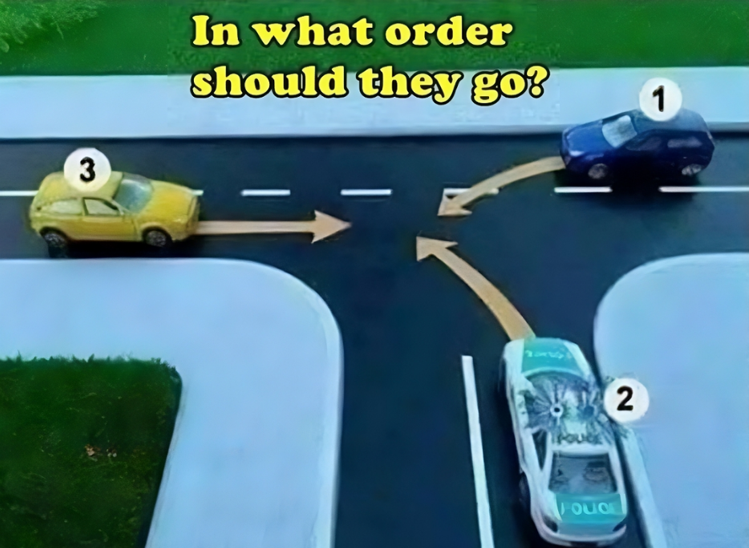The Traffic Test You Didn’t Expect: Can You Solve This Right-of-Way Challenge?
Traffic rules can often be confusing, especially when it comes to situations like a three-way intersection involving a police car and two civilian cars. So, which car goes first? Let’s break down the rules and opinions to determine the correct order.

Driving at intersections can be tricky, and when there’s a mix of different vehicles, including emergency ones like police cars, the decision of who moves first depends on a set of well-established road rules. But when opinions vary, how do we settle the debate? In this article, we’ll explore the factors that determine the right of way and analyze the situation step-by-step.
Understanding the Basics of Right of Way at Intersections
Before diving into the specific scenario, let’s revisit the basic principles of traffic laws and right-of-way rules. Right-of-way essentially dictates which vehicle has the priority to proceed at intersections, crosswalks, or junctions, ensuring safety and preventing accidents.
When you approach any intersection, the decision on who moves first is based on:
- Traffic lights and road signs: These typically control traffic.
- Emergency vehicles: Police cars, ambulances, and fire trucks with their sirens on have priority.
- Driver actions: Drivers must yield or stop based on the other vehicles’ direction of travel.
What Happens When There’s a Police Car Involved?
In our scenario, there are three vehicles: a police car and two civilian cars, each intending to go in a different direction. How do you decide who moves first?
When a police car is part of the equation, the situation changes. According to traffic laws, emergency vehicles like police cars have the right of way when their sirens or lights are on. So, if the police car is honking or has its sirens on, it is considered to be on duty, giving it the priority to go first.
However, if the police car isn’t honking or using its sirens, it follows the same rules as any other vehicle on the road, meaning it must follow regular traffic laws and yield when necessary.
The Opinion: “If the Police Car is Honking, It Goes First”
Some believe that if the police car honks, it means they are on duty and must move first. This makes sense because emergency vehicles like police cars are usually responding to critical situations. In such cases, they are granted immediate priority to clear the road and reach their destination quickly.
In this opinion:
- Police car (with siren) moves first.
- Car number 3 (going straight) follows because vehicles traveling straight have priority over those turning.
- Car number 1 (turning left) goes last because left-turning vehicles must yield to those going straight.
This sequence makes logical sense when you consider standard road rules and the specific conditions of the intersection.
Another Perspective: When the Police Car Does Not Use Its Siren
Another opinion considers the scenario where the police car is not honking or using its sirens. In this case, the police car has no special privileges and must follow regular traffic laws, just like any other vehicle.

According to this perspective, the order of vehicles changes because:
- Cars on the longitudinal road have to give way to cars on the crossroad.
- Car number 3, which is traveling straight, has the priority to go first.
- Car number 1, which is turning left, goes next, since it must yield to the vehicle going straight.
- The police car (without siren) goes last.
In this situation, the police car follows the general rules of yielding and does not receive any special treatment unless it’s actively responding to an emergency.
The Driving Test Rule: Prioritizing the Police Car and Straight Traffic
Some drivers base their decision on the principles they learned during their driving test. These principles emphasize the role of emergency vehicles and straight-moving cars.
According to this viewpoint:
- The police car (on duty) is the priority vehicle and goes first.
- Car number 3, which is going straight, follows next.
- Car number 1, turning left, goes last because left-turning vehicles must yield to straight-moving cars.
This method aligns with the logic of road priority, giving precedence to emergency services and simplifying the order by following common traffic flow rules.
What Happens at an Intersection Without Signs?
At intersections where there are no road signs or traffic lights, drivers must rely on their understanding of equal rights. In such scenarios, the order of vehicles is determined by who arrives at the intersection first and general traffic courtesy.
If there are no traffic lights or signs at the intersection, here’s one possible order based on this principle:
- The police car, assuming it has its siren on, goes first as it holds the right of way.
- Car number 1 goes next because it arrived at the intersection before the others.
- Car number 3 moves last, as it came to the intersection after the other vehicles.
This is an interpretation based on right-of-way principles when there’s no external signal dictating the order of movement.
Conclusion: What’s the Right Answer?
After examining the various opinions and the different principles applied to this scenario, the final answer seems to be:
- Police car (if on duty) goes first due to its priority as an emergency vehicle.
- Car number 3, which is traveling straight, follows after the police car.
- Car number 1, turning left, moves last since left turns generally yield to straight-moving traffic.
This order—police car, car number 3, car number 1—aligns with the majority of traffic laws and logical interpretation of intersection rules. However, it’s important to note that local traffic regulations may vary, so always refer to the specific rules applicable in your area when approaching intersections.
In conclusion, understanding right of way at intersections is critical for road safety, and when a police car is involved, it almost always has the priority to proceed, especially if it’s on duty.



